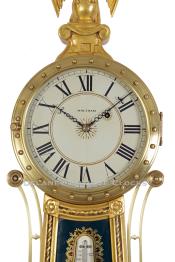Waltham Curtis Girandole Wall Timepiece. Number 24. 224131.
This is an outstanding centennial reproduction of Lemuel Curtis' Girandole Wall Timepiece. The Waltham Watch Company of Waltham, MA, made this example. Their catalog claimed that they had reproduced this famous clock so carefully that none of its original color, style, or charm was lost. This model, catalog #1510, was originally priced at $350. This was an expensive clock compared to their banjo clock lineup, which ranged between $40 and $125 for the fully gilded example.
This form was made famous by the Concord, Massachusetts, Clockmaker Lemuel Curtis. Curtis designed and sold a limited number of similar clocks in the 1820s. His clocks are eagerly sought by collectors and institutions today and are considered the ultimate expression of the wall timepiece form.
In 1802, Lemuel Curtis was an apprentice of the Willard's in Boston. In 1811, he moved to Concord and set up shop as a Clockmaker specializing in timepieces. Over the years, he made several "improvements" to Willard's original design. Examples of which are the single screw movement mounting system from the back of the case and alterations to the clocks suspension. Most clock collectors today would agree that Lemuel's ultimate achievement was the design of this impressive and unique form. However, this form was not a financial success. It is speculated that this is most likely due to the added expense of constructing and finishing the cases. As a result, a small number were originally produced, adding to their exclusivity. Most of these are now in the collections of our country's best Museums. Over the years, many individuals and some companies have since made reproductions of this form. Some include The Waltham Watch Company, Elmer Stennes, Ted Burleigh, and Foster Campos. This group also made limited numbers due to the cost of manufacturing this lavish case style. Some interpretations are more successful than others. This example is a faithful copy of the original form, making it a rare and privileged find for any collector, adding a sense of exclusivity and privilege to the potential buyer.
The various forms of the Waltham Clock and Waltham Watch Companies enjoyed a solid reputation for producing quality clocks. They made and sold Hall and Tall Case clocks and the Willard banjo form. They also offered a more industrial-looking line that had simpler lines. These clocks were targeted to be employed in various commercial enterprises. This form, the Girandole, was the icing on the cake. Current speculation suggests that Waltham made less than thirty examples. The form is considered by many to be America's most beautiful entrant in the horological world.
This clock measures approximately fifty-six inches long. The case is constructed in mahogany and is finished in shellac. The cases of this model are traditionally die-stamped by the manufacturer. This example is die-stamped on the back of the throat frame and on the throat case structure. The frames, bezel, carved eagle finial, and bracket are all wonderfully gilded in gold leaf. The condition of this gilding is excellent. Some areas have been professionally restored. The reverse-painted tablets are in excellent original condition. Both are painted-decorated on convex or bowed glass. The throat panel features an intricate border that is a traditional pattern. This border frames the red alcohol thermometer and engraved scale. The scale is brass, nicely engraved, and finished in silver. All of the Waltham versions of this form incorporate the thermometer in the throat. Below the thermometer window is an additional decoration with a red banner that reads "PATENT." The bottom circular tablet depicts a mythological scene, "AURORA." She is depicted racing across the sky on her chariot. The coloring and detailing are first-rate. The side arms on the case are brass and nicely formed. The dial is painted on metal and features the "WALTHAM" signature. The dial design features a closed minute ring, Large Roman-style hour numerals, two gilt rings, and additional gold work decorating the opening around the center and winding holes. The hands are a traditional Lemuel Curtis form, having concentric circles and barbed pointers.
The brass movement is mounted to the clock with screws that attach the back plate to the case. The movement is constructed in brass and is weight-driven. It is designed to run for eight days once fully wound. The quality is outstanding, ensuring its longevity and reliability. The front plate is decorated with a light damascene design. The gearing is brass and is supported on hardened steel shafts. This clock also has a dead-beat escapement, maintaining-power, and Geneva stop-work. The front plate is die-stamped with the Maker's name in the upper right corner, a testament to its quality and craftsmanship.
The lead weight is original to this clock.
This is truly an excellent example of a beautiful clock, a masterpiece that inspires admiration and appreciation for its maker's artistry and craftsmanship.
Inventory number 224131.
The Waltham Clock and Waltham Watch Companies, in their various forms, have been synonymous with quality timepieces. The Company was first established in Waltham, Massachusetts, in January of 1897 as the Waltham Clock Company. Their products, known for their excellent quality, included hall, shelf, and then wall clocks. In 1913, they merged with the watchmaking giant Waltham Watch, but continued to produce clocks under the Waltham Clock name until 1923, when the name was changed to the Waltham Watch and Clock Company. In 1925, the name was changed again to the Waltham Watch Co. The production of pendulum clocks is reported to have ceased around 1930.














